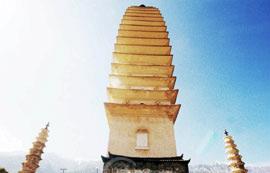CONTACT US
| +86-10-82600771 | |
| WhatsApp: +86-13911460247 | |
| Messenger: chinatournet | |
WeChat ID: callchinatour | |
Three pagodas, about 1 kilometer (0.6 mile) northwest of the ancient city of Dali, occupying a scenic location at the foot of Mt. Cangshan facing Erhai Lake, has a history of over 1,800 years. It is a symbol of the history of Dali City, and a record of the development of Buddhism in the area. As its name implies, Three Pagodas are made of three ancient independent pagodas forming a symmetrical triangle. This is unique in China. A visit to The Three Pagodas should not be missed by any visitor to Dali City.

The middle pagoda, Qianxun Pagoda, 69.13 meters (227 feet) high, is one of the highest pagodas of the Tang Dynasty (618Ł907), while the other lower two stand to the north and south sides of it. Qianxun Pagoda, now empty, previously could be climbed by ladder from the inside. However the ladder is now broken, and travelers now have no opportunity to climb up. Three Pagodas, Zhaozhou Bridge of Hebei Province, and Big Wild Goose Pagoda in Xian, Shaanxi Province, are three curiosities of Chinese ancient architecture.

Many sculptures of Buddha made of gold, silver, wood or crystal, Buddhist readings, and more than 600 various medicinal ingredients were found in Qianxun Pagoda, playing an important role in explaining the ancient history of Dali City. Study of Three Pagodas and the cultural relics that have been excavated at the site provide significant data for exploring the history, religion, and art of the area. Today, travelers can visit Three Pagodas at night, when it is illuminated providing a fantastic scene. Nearby on the 'marble street' there are many folk-craft workshops and stands specializing in marble and brick-painting.
Known for its resilience, Three Pagodas has survived several eras of severe earthquakes. The local government still makes a great effort to strengthen it to make it as strong as when it was built to ensure the preservation of this architectural treasure.